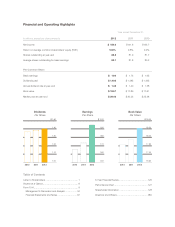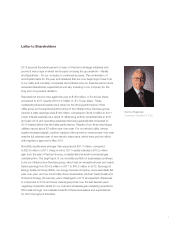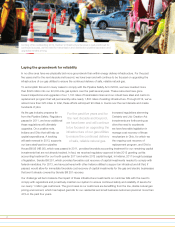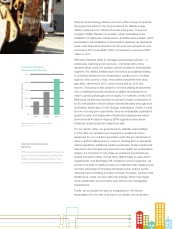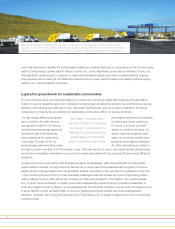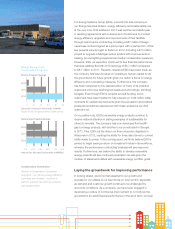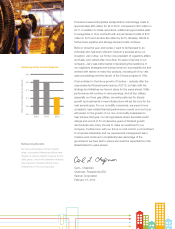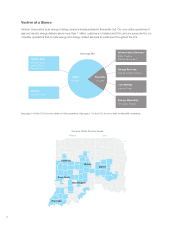Vectren 2012 Annual Report Download - page 6
Download and view the complete annual report
Please find page 6 of the 2012 Vectren annual report below. You can navigate through the pages in the report by either clicking on the pages listed below, or by using the keyword search tool below to find specific information within the annual report.
which will help ensure reliability for southwestern Indiana and western Kentucky in connecting our A.B. Brown power
plant to Duke Energy’s power plant in Gibson County, Ind., and to Big Rivers’ power plant in Webster County, Ky.
This significant capital project to expand our regional transmission system very much complements the ongoing
improvements we’re making at the distribution level and at our power plants to safely and reliably meet the energy
needs of our 142,000 electric customers.
Laying the groundwork for sustainable communities
For more than six years, we have been helping our customers use energy wisely after being the first gas utility in
Indiana to receive regulatory approval to implement a natural gas rate structure whereby we could embrace energy
efficiency; that change soon followed in Ohio. We haven’t looked back, and we’ve been a champion for energy
conservation to help lay the groundwork for sustainable communities within our service territories.
Our gas energy efficiency programs have helped customers cumulatively
save more than 48 million therms of natural gas, which equates to
enough gas to heat 61,000 homes for a year. Each year, we have
exceeded energy savings goals and expect to continue this trend. On
the electric side of the business, where customer programs have
been operational for nearly three years, we’re having a similar level
of success. Through 2012, our programs have helped residential
and business customers save nearly 80 million kilowatt hours, which is
enough to power more than 7,200 homes for a year. Although we do not have a decoupled electric rate structure,
we do have a regulatory mechanism to recover lost margin associated with the success of these energy efficiency
programs.
I’m also proud of our partnership with Energizing Indiana, the statewide, utility-supported effort to help further
reduce electric demand, through which we teamed up on a two-year home weatherization program for income-
eligible electric and gas customers in southwestern Indiana. Launched in July, we intend to weatherize more than
1,300 homes by the end of 2013 to help financially-challenged customers break the cycle of high energy bills in
older, inefficient homes. Other efforts are underway in cities such as Dayton, Ohio; Marion, Ind.; and Evansville,
Ind., in which we’ve embarked on holistic community sustainability projects aimed to jumpstart revitalization in
inner-city neighborhoods. In Dayton, we’ve partnered with the University of Dayton and an inner-city neighborhood
in south Dayton, known as Walnut Hills, to focus on neighborhood improvement and home weatherization
initiatives. Currently, we’re laying the groundwork in Terre Haute, Ind., to target a neighborhood in 2013 and begin
a similar project.
With five landfill-gas-to-energy projects under its belt, such as the one seen here in Dekalb County,
Georgia, and another under development, Energy Systems Group will look for more renewable energy
development opportunities as many states remain on target to meet their renewable portfolio goals.
We haven’t looked back,
and we’ve been a champion
for energy conservation to
help lay the groundwork for
sustainable communities
within our service territories.
4


